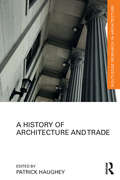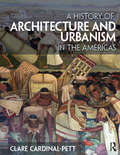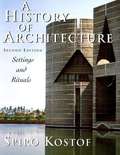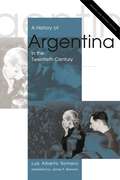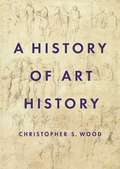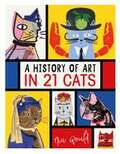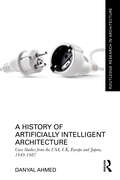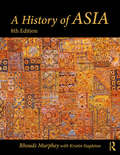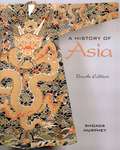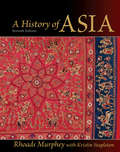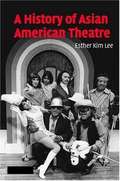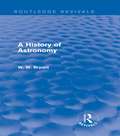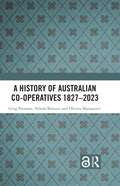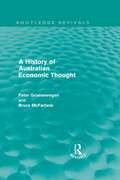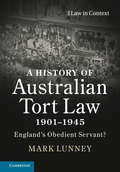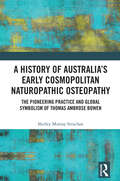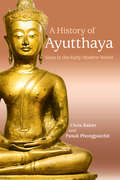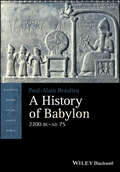- Table View
- List View
A History of Architectural Conservation
by Jukka JokilehtoThe first book to provide a full history of the development of architectural conservation, A History of Architectural Conservation is considered a landmark publication by architectural conservation students and professionals the world over. Twenty years after its first publication, this new edition of Jukka Jokilehto’s groundbreaking book continues the story to bring the history of architectural conservation right up to the modern day. Jokilehto draws on his distinguished career of over 40 years at ICCROM (International Centre for the Study of the Preservation and Restoration of Cultural Property, founded by UNESCO) to provide studies from Europe, the Middle East, the USA, Japan, India, China, Australia and South America. This accessible and well-written introduction to the history and theory of architectural conservation is richly illustrated in full colour and will be an essential go-to guide for students and practitioners worldwide.
A History of Architecture and Trade (Routledge Research in Architecture)
by Patrick HaugheyA History of Architecture and Trade draws together essays from an international roster of distinguished and emerging scholars to critically examine the important role architecture and urbanism played in the past five hundred years of global trading, moving away from a conventional Western narrative. The book uses an alternative holistic lens through which to view the development of architecture and trade, covering diverse topics such as the coercive urbanism of the Dutch East India Company; how slavery and capitalism shaped architecture and urbanization; and the importance of Islamic trading in the history of global trade. Each chapter examines a key site in history, using architecture, landscape and urban scale as evidence to show how trade has shaped them. It will appeal to scholars and researchers interested in areas such as world history, economic and trade history and architectural history.
A History of Architecture and Urbanism in the Americas
by Clare Cardinal-PettA History of Architecture and Urbanism in the Americas is the first comprehensive survey to narrate the urbanization of the Western Hemisphere, from the Arctic Circle to Antarctica, making it a vital resource to help you understand the built environment in this part of the world. The book combines the latest scholarship about the indigenous past with an environmental history approach covering issues of climate, geology, and biology, so that you'll see the relationship between urban and rural in a new, more inclusive way. Author Clare Cardinal-Pett tells the story chronologically, from the earliest-known human migrations into the Americas to the 1930s to reveal information and insights that weave across time and place so that you can develop a complex and nuanced understanding of human-made landscape forms, patterns of urbanization, and associated building typologies. Each chapter addresses developments throughout the hemisphere and includes information from various disciplines, original artwork, and historical photographs of everyday life, which - along with numerous maps, diagrams, and traditional building photographs - will train your eye to see the built environment as you read about it.
A History of Architecture: Settings and Rituals
by Spiro Kostof Gregory CastilloWhen the late Spiro Kostof's A History of Architecture appeared in 1985, it was hailed as a masterpiece--one of the finest books on architecture. The New York Times Book Review, called it "a magnificent guided tour through mankind's architecture."
A History of Argentina in the Twentieth Century: Updated and Revised Edition
by James P. Brennan Luis Alberto RomeroA History of Argentina in the Twentieth Century, originally published in Buenos Aires in 1994, attained instant status as a classic. Written as an introductory text for university students and the general public, it is a profound reflection on the “Argentine dilemma” and the challenges that the country faces as it tries to rebuild democracy. Luis Alberto Romero brilliantly and painstakingly reconstructs and analyzes Argentina’s tortuous, often tragic modern history, from the “alluvial society” born of mass immigration, to the dramatic years of Juan and Eva Perón, to the recent period of military dictatorship. For this second English-language edition, Romero has written new chapters covering the Kirchner decade (2003–13), the upheavals surrounding the country’s 2001 default on its foreign debt, and the tumultuous years that followed as Argentina sought to reestablish a role in the global economy while securing democratic governance and social peace.
A History of Argentina in the Twentieth Century: Updated and Revised Edition
by Luis Alberto RomeroA History of Argentina in the Twentieth Century, originally published in Buenos Aires in 1994, attained instant status as a classic. Written as an introductory text for university students and the general public, it is a profound reflection on the “Argentine dilemma” and the challenges that the country faces as it tries to rebuild democracy. Luis Alberto Romero brilliantly and painstakingly reconstructs and analyzes Argentina’s tortuous, often tragic modern history, from the “alluvial society” born of mass immigration, to the dramatic years of Juan and Eva Perón, to the recent period of military dictatorship. For this second English-language edition, Romero has written new chapters covering the Kirchner decade (2003–13), the upheavals surrounding the country’s 2001 default on its foreign debt, and the tumultuous years that followed as Argentina sought to reestablish a role in the global economy while securing democratic governance and social peace.
A History of Art History
by Christopher WoodAn authoritative history of art history from its medieval origins to its modern predicamentsIn this wide-ranging and authoritative book, the first of its kind in English, Christopher Wood tracks the evolution of the historical study of art from the late middle ages through the rise of the modern scholarly discipline of art history. Synthesizing and assessing a vast array of writings, episodes, and personalities, this original and accessible account of the development of art-historical thinking will appeal to readers both inside and outside the discipline.The book shows that the pioneering chroniclers of the Italian Renaissance—Lorenzo Ghiberti and Giorgio Vasari—measured every epoch against fixed standards of quality. Only in the Romantic era did art historians discover the virtues of medieval art, anticipating the relativism of the later nineteenth century, when art history learned to admire the art of all societies and to value every work as an index of its times. The major art historians of the modern era, however—Jacob Burckhardt, Aby Warburg, Heinrich Wölfflin, Erwin Panofsky, Meyer Schapiro, and Ernst Gombrich—struggled to adapt their work to the rupture of artistic modernism, leading to the current predicaments of the discipline.Combining erudition with clarity, this book makes a landmark contribution to the understanding of art history.
A History of Art in 21 Cats: From the Old Masters to the Modernists, The Moggy as Muse: An Illustrated Guide
by Nia GouldDiscover the principles of the world's most fascinating art movements through a series of 21 quirkily illustrated cats. From the Byzantine era through the Renaissance to Pop Art and beyond, these cat curators showcase the most important moments in the history of art. Innovative, informative and fun, this is art history as you've never experienced it before--with a large helping of cattitude. This is a great book for your sighted cat-loving friends! In this edition, the 21 main images are described using edited artificial intelligence. We have not described the numerous sub-images but your sighted friends will learn much about the art movements and chuckle over this book! For people without sight, we can learn the names and characteristics of the 21 arts movements and some of their practitioners so that when you go to a museum you'll be more in-the-know.
A History of Artificially Intelligent Architecture: Case Studies from the USA, UK, Europe and Japan, 1949–1987 (Routledge Research in Architecture)
by Danyal AhmedA History of Artificially Intelligent Architecture: Case Studies from the USA, UK, Europe and Japan, 1949-1987 provides a comprehensive survey of architectural projects exhibiting intelligence since the Late First Century right up to the present day. Tracing the social, scientific and technological developments, this book analyses case studies from both conceived and executed architectural projects by Architects and Cyberneticians from the United States, United Kingdom, Europe and Japan from 1949-87. From the Late First Century through to the Seventeenth Century, the scientific endeavors of the Hero of Alexandria, Ramon Llull, Paracelsus, René Descartes, Jacques de Vaucanson, Pierre Jacquet-Droz, and Charles Babbage have been presented in which they attempted to review, analyse and conclude the notion of artificial intelligence. Coming to the Twenty-First Century and witnessing a period, particularly from 1949-87, where nothing had been constant, Architects and Cyberneticians whose architectural projects attempted to simulate intelligence include Cedric Price, Richard Saul Wurman, Nicholas Negroponte, Kenzo Tange, Arata Isozaki, Charles Eames, Ezra D. Ehrenkrantz, Richard Rogers, Renzo Piano, and Gordon Pask respectively. This book asks: How have Polymaths, Architects and Cyberneticians simulated artificial intelligence in their scientific/architectural projects? Is it possible to define intelligence purely based on the history of architecture? Or, on a more extensive level, is it possible to view artificial intelligence originating from the history of architecture instead of computational paradigm? The transdisciplinarity of the book makes it of interest to researchers and students of technologically advanced architecture’s history, theory, and criticism, artificial intelligence, cybernetics, information and communications, urban and sustainable design, ergonomics, computer applications, and digital design and fabrication.
A History of Asia
by Kristin Stapleton Rhoads MurpheyA History of Asia is the only textbook to provide a historical overview of the whole of this region, encompassing India, China, Korea, Japan, and Southeast Asia. Engaging and lively, it chronicles the complex political, social, and intellectual histories of the area from prehistory to the present day. Taking a comparative approach throughout, the book offers a balanced history of each major tradition, also dedicating coverage to countries or regions such as Vietnam and Central Asia that are less frequently discussed in depth. This eighth edition has been streamlined and updated to reflect the most recent scholarship on Asian history, bringing the book up to date with recent events and key trends in historical research. Highlights of the book include close-up portraits of significant Asian cities, detailed discussion of environmental factors that have shaped Asian history, quotes from Asian poetry and philosophical writing, and attention to questions of gender and national identity. Highly illustrated with images and maps, each chapter also contains discussion questions, primary source excerpts, and in-depth boxed features. Written clearly throughout, A History of Asia is the perfect introductory textbook for all students of the history, culture, and politics of this fascinating region.
A History of Asia
by Rhoads MurpheyWritten by a leading scholar, A History of Asia is the only text to cover the area known as Monsoon Asia India, China, Southeast Asia, Korea, and Japan from earliest of times to the present. Its extensive analysis integrates the complex and diverse political, social, intellectual, and economic histories of this area with an engaging and lively style. Popular because of its scope and coverage, as well as its illustrations, maps, and many boxed primary sources, A History of Asia is a comprehensive, balanced exploration of the 5000-year sweep of Asian history.
A History of Asia
by Rhoads MurpheyA History of Asia is the only text to cover the area known as "monsoon Asia" - India, China, Korea, Japan, and Southeast Asia--from the earliest times to the present. Written by leading scholar Rhoads Murphey, the book uses an engaging, lively tone to chronicle the complex political, social, intellectual, and economic histories of this area. Popular because of its scope and coverage, as well as its illustrations, maps, and many boxed primary sources, the new edition of A History of Asia continues as a leader in its field.
A History of Asian American Theatre (Cambridge Studies in American Theatre and Drama #26)
by Esther Kim LeeIn 1965, the first Asian American theatre company, the East West players, was founded by a group of actors who wanted to find better opportunities in the acting industry. Forty years later, Asian American theatre is one of the fastest-growing theatre sectors with over thirty active theatre companies and numerous award-winning artists such as Frank Chin, Jessica Hagedorn, Ping Chong, David Henry Hwang, Philip Kan Gotanda, Velina Hasu, and B. D. Wong. Based on over seventy interviews, this book surveys the history of Asian American theatre from 1965 to 2005 with focus on actors, playwrights, companies, audiences, and communities. Emphasizing historical contexts, Esther Kim Lee examines how issues of cultural nationalism, interculturalism, and identity politics affect a racially defined theatre. Addressing issues ranging from actor's activism to Asian Diaspora, the book documents how Asian American theatre has become an indispensable part of American culture.
A History of Astronomy (Routledge Revivals)
by Walter W. BryantA History of Astronomy, first published in 1907, offers a comprehensive introduction to the steady development of the science since its inception in the ancient world up to the momentous progress of the nineteenth century. It includes biographical material relating to the most famous names in the study of astronomy – Copernicus, Galileo, Newton, Herschel – and their contributions, clear and accessible discussions of key discoveries, as well as detailing the incremental steps in technology with which many of the turning points in astronomy were intimately bound up.
A History of Australasian Economic Thought (The Routledge History of Economic Thought)
by Alex MillmowThis overview of Australasian economic thought presents the first analysis of the Australian economic contribution for 25 years, and is the first to offer a panoramic sweeping account of New Zealand economic thought. Those two countries, both at the start of the twentieth century and at its end, excelled at innovative economic practices and harbouring unique economic institutions. A History of Australasian Economic Thought explains how Australian and New Zealand economists exerted influence on economic thought and contributed to the economic life of their respective countries in the twentieth century. Besides surveying theorists and innovators, this book also considers some of the key expositors and builders of the academic economics profession in both countries. The book covers key economic events including the Great Depression, the Second World War, the post-war boom and the great inflation that overtook it and, lastly, the economic reform programmes that both Australia and New Zealand undertook in the 1980s. Through the interplay of economic events and economic thought, this book shows how Australasian economists influenced, to differing degrees, economic policy in their respective countries. This book is of great importance to those who are interested in and study the history of economic thought, economic theory and philosophy, and philosophy of social science, as well as Australasian economics.
A History of Australian Co-operatives 1827-2023
by Greg Patmore Nikola Balnave Olivera MarjanovicCo-operatives provide a different approach to organising business through their ideals of member ownership and democratic practice. Every co-operative member has an equal vote regardless of his or her own personal capital investment. They take a variety of different forms, including consumer co-operatives, agricultural co-operatives, worker co-operatives and financial co-operatives. Patmore, Balnave and Marjanovic provide a perspective on Australian co-operative development within a conceptual framework and international context since the 1820s by exploring the economic, political and social factors that explain their varying fortunes. Drawing upon the Visual Historical Atlas of Australian Co-operatives, a significant database of Australian co-operatives and a variety of historical sources, this book provides a detailed historical analysis of their development, from their inception in Australia to today. Australian co-operatives were heavily dependent on state sympathy for their growth and vulnerable to ideas that challenged collective organisation such as Neo-liberalism. Despite these challenges, the co-operative business model has persisted and since 2009, there has been resurgence of interest and organisation that may provide a platform for future growth. A useful resource for practitioners, students, educators, policy makers and researchers that highlights a significant alternative business model to the Investor-Owned Business and state enterprise.
A History of Australian Co-operatives 1827–2023
by Greg Patmore Nikola Balnave Olivera MarjanovicCo-operatives provide a different approach to organising business through their ideals of member ownership and democratic practice. Every co-operative member has an equal vote regardless of his or her own personal capital investment. They take a variety of different forms, including consumer co-operatives, agricultural co-operatives, worker co-operatives and financial co-operatives.Patmore, Balnave and Marjanovic provide a perspective on Australian co-operative development within a conceptual framework and international context since the 1820s by exploring the economic, political and social factors that explain their varying fortunes. Drawing upon the Visual Historical Atlas of Australian Co-operatives, a significant database of Australian co-operatives and a variety of historical sources, this book provides a detailed historical analysis of their development, from their inception in Australia to today. Australian co-operatives were heavily dependent on state sympathy for their growth and vulnerable to ideas that challenged collective organisation such as Neo-liberalism. Despite these challenges, the co-operative business model has persisted and since 2009, there has been resurgence of interest and organisation that may provide a platform for future growth.A useful resource for practitioners, students, educators, policy makers and researchers that highlights a significant alternative business model to the Investor-Owned Business and state enterprise.The Open Access version of this book, available at http://www.taylorfrancis.com, has been made available under a Creative Commons [Attribution-Non Commercial-No Derivatives (CC-BY-NC-ND)] 4.0 license.
A History of Australian Economic Thought (Routledge Revivals)
by Peter Groenewegen Bruce McFarlaneFirst published in 1990, this book presents an original and comprehensive overview of Australian economic thought. The authors stress, by way of introduction, the many important innovative contributions Australian economists have made to thought worldwide. As the argument develops, the work of major figures is discussed in detail in addition to the role of different journals and economic societies.
A History of Australian Tort Law 1901–1945: England's Obedient Servant? (Law in Context)
by Mark LunneyLittle attention has been paid to the development of Australian private law throughout the first half of the twentieth century. Using the law of tort as an example, Mark Lunney argues that Australian contributions to common law development need to be viewed in the context of the British race patriotism that characterised the intellectual and cultural milieu of Australian legal practitioners. Using not only primary legal materials but also newspapers and other secondary sources, he traces Australian developments to what Australian lawyers viewed as British common law. The interaction between formal legal doctrine and the wider Australian contexts in which that doctrine applied provided considerable opportunities for nuanced innovation in both the legal rules themselves and in their application. This book will be of interest to both lawyers and historians keen to see how notions of Australian identity have contributed to the development of an Australian law. Places twentieth-century Australian tort law development in the context of British race patriotism. Recognises the cultural and intellectual environment in which Australian lawyers operated and how this environment influenced their perceptions of their contribution. Provides a new account of the relationship between general conceptions of national identity and the development of an Australian law; in particular, how far Australian law differed from the English common law it was assumed to follow.
A History of Australia’s Early Cosmopolitan Naturopathic Osteopathy: The Pioneering Practice and Global Symbolism of Thomas Ambrose Bowen
by Shirley Murray StrachanRevealing the forgotten ideas and philosophy behind early naturopathic osteopathy, Shirley Murray Strachan presents a reoriented historical view of Thomas Ambrose Bowen and his work, breaking from the prevailing twentieth-century legitimation narrative of mainstream chiropractic and osteopathy and exploring the contributions and practices of Australia’s early cosmopolitan naturopathic osteopathy pioneers FG Roberts and Maurice Blackmore.Viewing Bowen’s practice and symbolism through a historical lens, the book examines the forgotten world of early cosmopolitan Australian osteopathy, debunking popular posthumous commercialised claims about Bowen’s work and asserts the importance of traditional approaches in naturopathic osteopathy. Though an interrogation of conflicting origin stories and myths about Bowen’s work, it highlights the important contributions of naturopathic pioneers FG Roberts and Maurice Blackmore. The background narrative is the struggle of mainstream chiropractic and osteopathy seeking professional recognition and forged from in-fighting between overseas and Australian chiropractic and osteopathic political interests. Counterposed is the posthumous popular interpretations that orphaned Bowen’s work from its wellsprings in naturopathic osteopathy.This is an accessible book for historians and practitioners of early osteopathy, chiropractic and naturopathy, especially to the large, international community of accredited Bowen therapists.
A History of Ayutthaya: Siam in the Early Modern World
by Chris Baker Pasuk PhongpaichitEarly European visitors placed Ayutthaya alongside China and India as the great powers of Asia. Yet in 1767 the city was destroyed and its history has been neglected. This book is the first study of Ayutthaya from its emergence in the thirteenth century until its fall. It offers a wide-ranging view of social, political, and cultural history with focus on commerce, kingship, Buddhism, and war. By drawing on a wide range of sources including chronicles, accounts by Europeans, Chinese, Persians, and Japanese, law, literature, art, landscape, and language, the book presents early Siam as a 'commercial' society, not the peasant society usually assumed. Baker and Phongpaichit attribute the fall of the city not to internal conflict or dynastic decline but failure to manage the social and political consequences of prosperity. This book is essential reading for all those interested in the history of Southeast Asia and the early modern world.
A History of Babylon, 2200 BC - AD 75 (Blackwell History of the Ancient World)
by Paul-Alain BeaulieuProvides a new narrative history of the ancient world, from the beginnings of civilization in the ancient Near East and Egypt to the fall of Constantinople Written by an expert in the field, this book presents a narrative history of Babylon from the time of its First Dynasty (1880-1595) until the last centuries of the city’s existence during the Hellenistic and Parthian periods (ca. 331-75 AD). Unlike other texts on Ancient Near Eastern and Mesopotamian history, it offers a unique focus on Babylon and Babylonia, while still providing readers with an awareness of the interaction with other states and peoples. Organized chronologically, it places the various socio-economic and cultural developments and institutions in their historical context. The book also gives religious and intellectual developments more respectable coverage than books that have come before it. A History of Babylon, 2200 BC – AD 75 teaches readers about the most important phase in the development of Mesopotamian culture. The book offers in-depth chapter coverage on the Sumero-Addadian Background, the rise of Babylon, the decline of the first dynasty, Kassite ascendancy, the second dynasty of Isin, Arameans and Chaldeans, the Assyrian century, the imperial heyday, and Babylon under foreign rule. Focuses on Babylon and Babylonia Written by a highly regarded Assyriologist Part of the very successful Histories of the Ancient World series An excellent resource for students, instructors, and scholars A History of Babylon, 2200 BC - AD 75 is a profound text that will be ideal for upper-level undergraduate and graduate courses on Ancient Near Eastern and Mesopotamian history and scholars of the subject.
A History of Badger Baseball: The Rise and Fall of America's Pastime at the University of Wisconsin
by Steven D. SchmittFor more than a century, the University of Wisconsin fielded baseball teams. This comprehensive history combines colorful stories from the archives, interviews with former players and coaches, a wealth of historic photographs, and the statistics beloved by fans of the game. The earliest intercollegiate varsity sport at Wisconsin, the baseball team was founded in 1870, less than a decade after the start of the Civil War. It dominated its first league, made an unprecedented trip to Japan in 1909, survived Wisconsin's chilly spring weather, two world wars, and perennial budget crises, producing some of the finest players in Big Ten history—and more than a few major leaguers. Fan traditions included torchlight parades, kazoos, and the student band playing "A Hot Time in the Old Town Tonight" as early as 1901. There is painful history here, too. African Americans played on Wisconsin's first Big Ten championship team in 1902, including team captain Julian Ware, but there were none on the team between 1904 and 1960. Heartbreaking to many fans was the 1991 decision to discontinue baseball as a varsity sport at the university. Today, Wisconsin is the only member of the Big Ten conference without a men's baseball team. Appendixes provide details of team records and coaches, All Big Ten and All American selections, Badgers in the major leagues, and Badgers in the amateur free-agent draft.
A History of Balance, 1250-1375
by Joel KayeThe ideal of balance and its association with what is ordered, just, and healthful remained unchanged throughout the medieval period. The central place allotted to balance in the workings of nature and society also remained unchanged. What changed within the culture of scholasticism, between approximately 1280 and 1360, was the emergence of a greatly expanded sense of what balance is and can be. In this groundbreaking history of balance, Joel Kaye reveals that this new sense of balance and its potentialities became the basis of a new model of equilibrium, shaped and shared by the most acute and innovative thinkers of the period. Through a focus on four disciplines - scholastic economic thought, political thought, medical thought, and natural philosophy - Kaye's book reveals that this new model of equilibrium opened up striking new vistas of imaginative and speculative possibility, making possible a profound re-thinking of the world and its workings.
A History of Bangladesh
by Willem Van SchendelBangladesh is a new name for an old land whose history is little known to the wider world. A country chiefly famous in the West for media images of poverty, underdevelopment, and natural disasters, Bangladesh did not exist as an independent state until 1971. Willem van Schendel's history reveals the country's vibrant, colourful past and its diverse culture as it navigates the extraordinary twists and turns that have created modern Bangladesh. The story begins with the early geological history of the delta which has decisively shaped Bangladesh society. The narrative then moves chronologically through the era of colonial rule, the partition of Bengal, the war with Pakistan and the birth of Bangladesh as an independent state. In so doing, it reveals the forces that have made Bangladesh what it is today. This is an eloquent introduction to a fascinating country and its resilient and inventive people.

